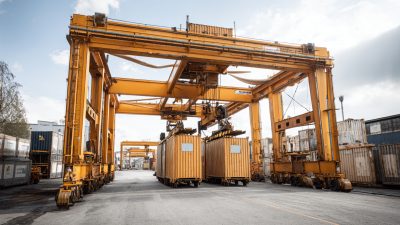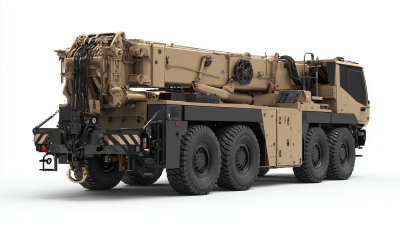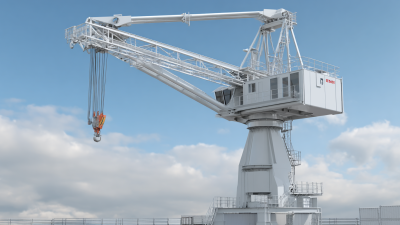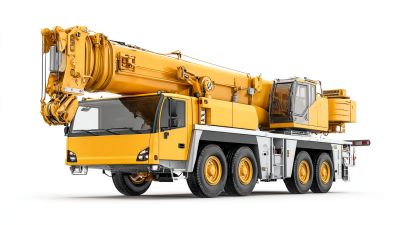Leave Your Message
-
Phone
-
E-mail
-
WhatsApp
In the rapidly evolving maritime industry, the significance of a Shipyard Gantry Crane cannot be overstated. These cranes are essential for the efficient handling and movement of heavy cargo, especially in shipbuilding and repair operations. According to a recent report by MarketsandMarkets, the global market for gantry cranes is projected to reach USD 4.1 billion by 2025, growing at a CAGR of 5.5% due to increasing demand for automation in ports and shipyards.

The versatility and heavy-lifting capabilities of Shipyard Gantry Cranes not only enhance productivity but also improve safety standards in high-risk environments. With their robust design and innovative features, these cranes are pivotal in streamlining operations and minimizing downtime, making them a critical asset for any shipyard. Understanding the best features of Shipyard Gantry Cranes can help businesses optimize their logistics and operational efficiency, ensuring they remain competitive in today's fast-paced market.
Shipyard gantry cranes play a vital role in heavy lifting operations, providing a range of advantages that enhance efficiency and safety. These cranes are specifically designed to handle the substantial weights and large dimensions of ship components, making them ideal for shipbuilding and repair facilities. One of the key features is their ability to move along tracks, allowing for flexible positioning and the capability to lift materials from various locations within the yard. This mobility not only saves time but also helps to optimize workflow.
Tip: When selecting a gantry crane, consider the lifting capacity and span. Ensure that the crane you choose can handle your specific operational needs without compromising safety or efficiency.
Another significant advantage of shipyard gantry cranes is their stability and robustness. Constructed with durable materials, these cranes are built to withstand harsh weather conditions and heavy loads, significantly reducing the risk of accidents during lifting operations. Moreover, many modern gantry cranes are equipped with advanced control systems, enhancing precision and allowing operators to perform lifts with greater confidence.
Tip: Always conduct regular maintenance checks on your gantry crane to ensure optimal performance and longevity, reducing downtime and costly repairs.
The structural design of gantry cranes is crucial for their stability and performance in various industrial environments. These cranes typically consist of a bridge supported by two or more legs, which allows them to straddle a workspace. The design ensures that the weight of the lifting load is distributed evenly across the structure, minimizing the risk of tipping or swaying during operation. Key materials such as steel are commonly used due to their strength and durability, providing a robust framework that can withstand heavy loads and harsh conditions.
Understanding the stability of gantry cranes involves exploring several design aspects, including base width, center of gravity, and the height of the crane. A wider base enhances stability by lowering the center of gravity, preventing topple in high winds or when lifting asymmetrical loads. Engineers also consider the operational environment, such as wind load and ground conditions, to optimize the crane's design for safe performance. Each of these factors plays a significant role in ensuring that gantry cranes operate efficiently without compromising safety, making them invaluable tools in shipyards and other heavy lifting industries.
| Feature | Description | Benefits | Typical Applications |
|---|---|---|---|
| Modular Design | Flexible construction that allows cranes to be disassembled and reassembled. | Easier transport and storage, adaptability to different work sites. | Shipbuilding, construction sites, and large manufacturing areas. |
| Heavy Load Capacity | Designed to lift and transport heavy materials safely. | Increased efficiency in handling large products. | Shipyard operations and large-scale construction. |
| High Stability | Designed with a low center of gravity to minimize tipping. | Enhances safety during operations. | Heavy lifting in adverse conditions. |
| Versatile Maneuverability | Can move along tracks or be mobile on wheels. | Flexibility to operate in various environments. | General lifting tasks in diverse industrial settings. |
| Advanced Safety Features | Includes overload protection, emergency stop systems, and safety alarms. | Prevents accidents and enhances operational safety. | Shipyards, warehouses, and construction sites. |
| Customizable Features | Can be equipped with various options such as hook types, lighting, and remote control. | Tailors crane operations to specific tasks. | Specific industrial tasks that require unique handling solutions. |
| Efficiency in Operation | Optimized for quick setup and operation cycles. | Increased productivity and reduced downtime. | High-demand shipping and construction tasks. |
Automation technology is fundamentally transforming the operations of gantry cranes at ports worldwide, leading to increased efficiency and productivity. With advancements in smart technologies, including AI, IoT, and blockchain, ports can significantly optimize their operations. For instance, automated systems enable real-time tracking and management of cargo, which helps alleviate congestion that has plagued major ports. According to industry reports, the automation of crane operations can reduce operational costs by up to 30%, making them not only faster but also more reliable.

At the forefront of this automation revolution are remote-controlled and automated gantry cranes. The Port of Hamburg recently welcomed its first remote-controlled container gantry cranes, signaling a shift towards more innovative solutions in cargo handling. Such automation not only streamlines the loading and unloading processes but also enhances safety by minimizing human error. As the global demand for efficient cargo handling solutions rises, the market for port cranes is expected to continue growing, with industry projections indicating a significant increase in automated systems across major shipping hubs over the next few years. This shift towards automation represents a critical step in achieving sustainable port operations and meeting the challenges of an increasingly fragmented global supply chain.
Shipyard gantry cranes play a crucial role in improving safety standards in industrial environments, significantly reducing the risk of workplace accidents. One of the most important safety features is the advanced load-monitoring system. This technology ensures that operators are always aware of the weight they are lifting, minimizing the risk of overloading the crane. When lifting excessive loads, alarms can alert the operator, allowing for quick adjustments and preventing potentially hazardous situations.
Additionally, many modern gantry cranes come equipped with enhanced visibility features, such as LED lighting and color-coded indicators. These improvements assist operators in monitoring their surroundings, thereby reducing the chances of collisions or mishaps during operation. Another key safety feature is the integration of automated braking systems. These systems can halt crane movement immediately if an obstruction is detected, providing an extra layer of protection for both workers and equipment. By implementing these safety features, shipyard gantry cranes not only improve operational efficiency but also create a safer workplace environment.
 When it comes to the longevity and efficiency of shipyard gantry cranes, material selection plays a pivotal role. Durability and performance are significantly influenced by the materials used in the crane's construction. Steel is often the primary choice due to its strength and resistance to deformation under heavy loads. However, advancements in composite materials are also emerging, offering lighter options that can enhance mobility without sacrificing structural integrity. These innovative materials can withstand harsh marine environments, ensuring that cranes remain operational over long periods.
When it comes to the longevity and efficiency of shipyard gantry cranes, material selection plays a pivotal role. Durability and performance are significantly influenced by the materials used in the crane's construction. Steel is often the primary choice due to its strength and resistance to deformation under heavy loads. However, advancements in composite materials are also emerging, offering lighter options that can enhance mobility without sacrificing structural integrity. These innovative materials can withstand harsh marine environments, ensuring that cranes remain operational over long periods.
Tip: When selecting a gantry crane, consider the specific environmental conditions of your shipyard. A crane designed with corrosion-resistant coatings can greatly extend its lifespan, especially in coastal areas where salt exposure is high.
Enhancing gantry crane performance also involves understanding how different materials react to various stresses. For instance, aluminum, while lightweight, may not support heavy loads as effectively as higher-grade steel. Balancing weight and strength is crucial for optimal crane operation.
Tip: Regular maintenance checks are essential. Inspect elements like cables, wheels, and joints for wear, and ensure that materials are holding up against the rigors of daily use, especially if lighter materials are utilized.






